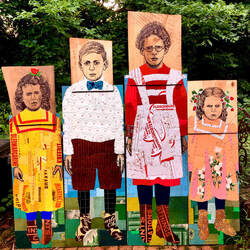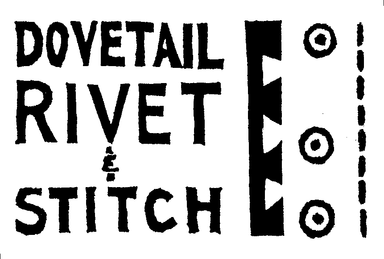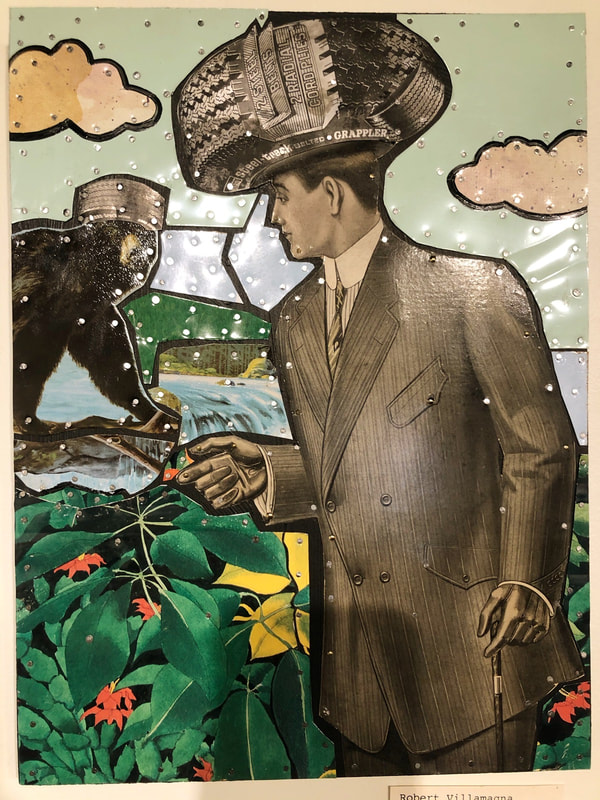|
Robert Villamagna is a West Virginian mixed media artist, known in our shop for his metal paintings. His bold colors and comical compositions sit proudly on our walls in the gallery space. I had a fun interview with him that I hope you enjoy reading! As someone who has very little knowledge about metal working, I first asked Robert about his material process. “I would estimate that about 75% of my ideas start out in one of my many sketchbooks. From there I usually create a rough sketch directly on my support (wood panel, medium-density fibreboard panel, or a found support such as an old desk drawer) using a Sharpie. Then I begin searching the studio for materials...which may take a few hours or several days. [Then] I begin putting the actual piece together...I may spend days, or even weeks, on a piece. My tools primarily consist of tin snips, hammers, various fasteners (nails, rivets, industrial adhesives), and power tools...My work may be classified as 2D, but in many cases it falls into a 3D category. It all depends on what and how much material or objects I am attaching to the plane or support. At a certain point the work does become frontal sculpture.” The metal works produce a bas or low relief effect. A bas relief is a sculptural technique in which the artist carves or chisels away at a material to create an image that is basically a sculptural painting. The piece is frontal like a painting, unlike other kinds of sculpture in which the viewer can move around the object and view the piece from all sides. I find it ironic that his pieces are relief-like and yet are created using an additive rather than reductive process--he builds up the pieces by adding material to the surface rather than carving away at the material to make the image. This relation to bas relief is further enhanced by his subject matter. Traditional Greek and Roman relief pieces depict scenes of stories and myths, and Robert’s pieces also have a narrative quality. He spoke about this narrative quality and how he views it in his work: “The “stories” you refer to come from a variety of sources. A source may be a memory from my life, a line I’ve heard in a song, a piece of a conversation I may have overheard at the grocery store, or something suggested by the materials themselves. In many cases the story that I feel I am telling in a particular piece may not be the story that a viewer might “read” into one of my pieces. In most cases, I’m OK with that.” Robert mentioned that he normally sketches out his compositions before proceeding, though often these sketches act as more of a guide than a set plan, which is true for how he approaches narratives and stories in his pieces as well. I asked him about how much preconception goes into his pieces and how much he discovers along the way: “All of my work consists of exploring. That’s the nature of the materials I use. I may have a preconceived idea in most cases, but the actual building of the piece is based on lots of experimentation with various materials and found objects.” Next I asked him about the visual tools he uses in his work, namely composition and color. “I usually approach value first, color second. There are certain elements in each piece that I want to get attention, so looking at value is very important here. Color plays an important role, of course, but it may be affected by the subject of the piece, the mood I wish to convey, or what material colors I have on hand.” As a viewer, I see saturation and contrast as important to his works in addition to tone. He thinks about neutrals in his pieces and how they contribute to the figure-ground relationships in the works, playing with what he wants to stand out and what sinks back. In thinking about all these elements in his pieces -- narrative, color, composition, materials, etc. -- I asked Robert to go into detail about the creation of the two pieces we have in the shop, Drink Your Money and Of Like Mind. “Drink Your Money was created for an exhibition titled “Almost Level, West Virginia,” a reflection on environmental issues in our state. I had a vision for a glass filled with money, so the negative space was this: keep it simple, use dark values to pop the hand and glass, and keep it warm.” “Of Like Mind is just me playing, silliness meets surreal. I had these metal tire images and wondered how I might use them. When I decided on the man and bear encounter, it just became a simple task of seeing what materials I had on hand representing “outdoors” and in appropriate colors that would not take the focus off my two main characters.” Robert’s practice, like all of our lives, has been deeply affected by the COVID pandemic. I asked what adjustments he had to make due to the pandemic, and he told me “I probably put in even more studio time during the pandemic since we are not traveling, attending concerts, etc. While my wife and I had COVID in August, I made nothing for about three weeks. As my symptoms dissipated, I began going back into the studio. However, it was difficult at first. I could only put in 90 minutes a day and I would be exhausted. Over the next few weeks I would closely build that up to two hours, three hours, etc. Now I am back in the studio full time.” Lastly, I asked Robert what he is working on now, now that things have settled into more of a rhythm and he is (thankfully!) COVID-free. “Right now I am drawing a simple layout of our house lot so that I can present it to our local planning board. I want to place a 12” x 16” storage shed on our property to store metal and objects. I’m trying to free up more space in my studio. And I just completed my “Gimbels Series”, a group of twelve works, each using a printing plate from the advertising department of the Pittsburgh Gimbels store. I wanted to show these as a group, but it’s tough to do during this pandemic.” “Right now I have a bunch of things I want to pursue. A six foot Mothman figure. A piece based on an old photo of a young man holding a fiddle, his mom behind him in the doorway of a log cabin. I’m also thinking about doing some large abstract metal pieces. I love non-objective abstract painting and I’d like to see if I could pull that off in metal and found objects.” If you want to see more of Robert’s work and what he is currently creating, check out his website here. I’d like to thank Robert for taking the time to answer all of my questions so thoroughly and thoughtfully! Thanks for reading, Louise  Robert sent this picture of a piece in which he combines drawing and metal, a process he hopes to use again in other works. This one is titled "Siblings."
0 Comments
Leave a Reply. |
AuthorLouise Rossiter writes about artists featured in our shop! Archives
April 2021
Categories |


 RSS Feed
RSS Feed
